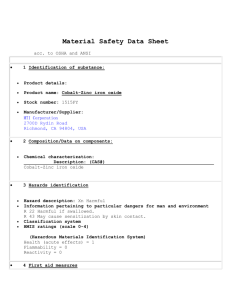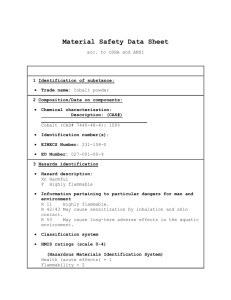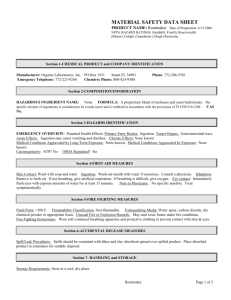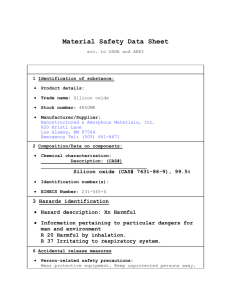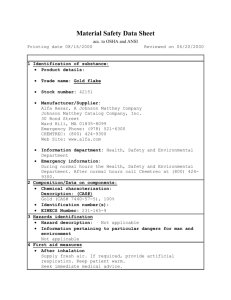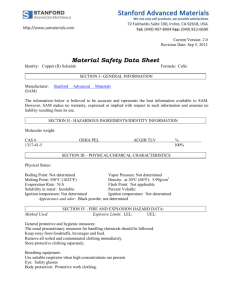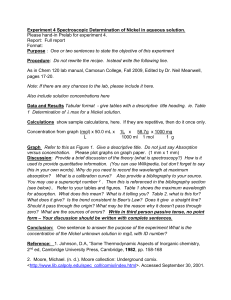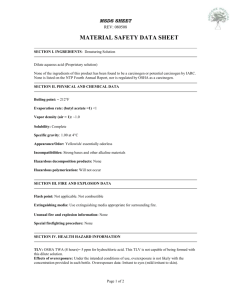MSDS
advertisement
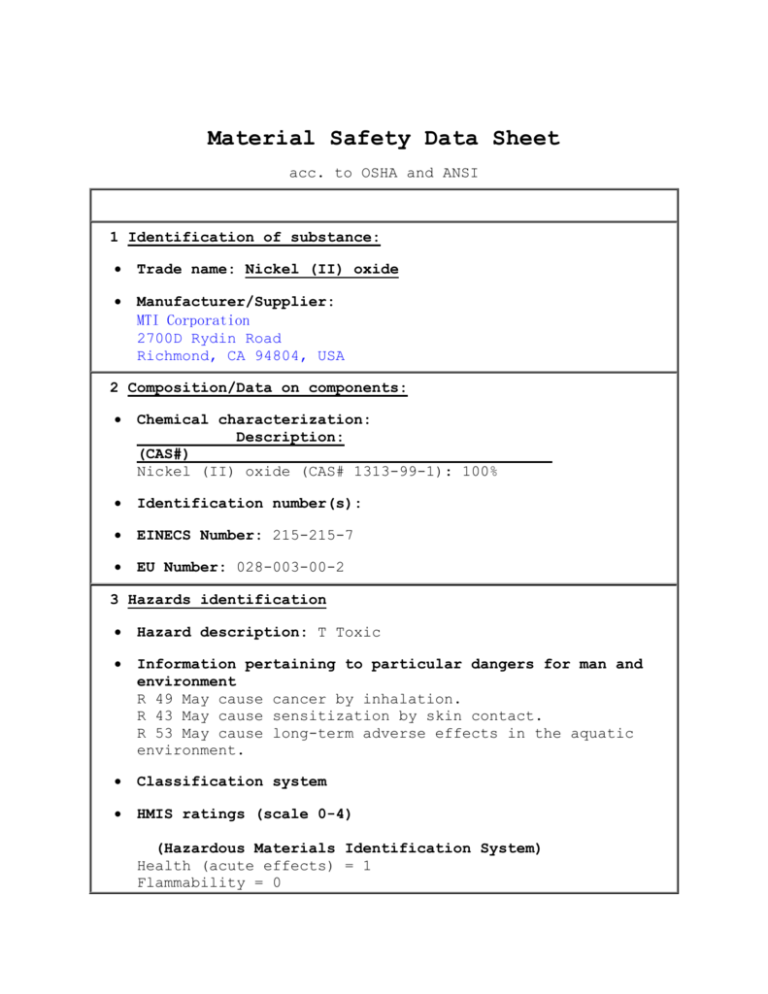
Material Safety Data Sheet acc. to OSHA and ANSI 1 Identification of substance: Trade name: Nickel (II) oxide Manufacturer/Supplier: MTI Corporation 2700D Rydin Road Richmond, CA 94804, USA 2 Composition/Data on components: Chemical characterization: Description: (CAS#) Nickel (II) oxide (CAS# 1313-99-1): 100% Identification number(s): EINECS Number: 215-215-7 EU Number: 028-003-00-2 3 Hazards identification Hazard description: T Toxic Information pertaining to particular dangers for man and environment R 49 May cause cancer by inhalation. R 43 May cause sensitization by skin contact. R 53 May cause long-term adverse effects in the aquatic environment. Classification system HMIS ratings (scale 0-4) (Hazardous Materials Identification System) Health (acute effects) = 1 Flammability = 0 Reactivity = 0 4 First aid measures After inhalation Supply fresh air and to be sure call for a doctor. Supply fresh air. If required, provide artificial respiration. Keep patient warm. Seek immediate medical advice. After skin contact Immediately wash with water and soap and rinse thoroughly. Seek immediate medical advice. After eye contact Rinse opened eye for several minutes under running water. Then consult a doctor. After swallowing Seek immediate medical advice. 5 Fire fighting measures Suitable extinguishing agents Carbon dioxide, extinguishing powder or water spray. Fight larger fires with water spray or alcohol resistant foam. Special hazards caused by the material, its products of combustion or resulting gases: In case of fire, the following can be released: Toxic metal oxide fume Protective equipment: Wear self-contained respirator. Wear fully protective impervious suit. 6 Accidental release measures Person-related safety precautions: Wear protective equipment. Keep unprotected persons away. Ensure adequate ventilation Measures for environmental protection: Do not allow material to be released to the environment without proper governmental permits. Measures for cleaning/collecting: Dispose contaminated material as waste according to item 13. Ensure adequate ventilation. Additional information: See Section 7 for information on safe handling See Section 8 for information on personal protection equipment. See Section 13 for disposal information. 7 Handling and storage Handling Information for safe handling: Keep container tightly sealed. Store in cool, dry place in tightly closed containers. Ensure good ventilation at the workplace. Open and handle container with care. Information about protection against explosions and fires: No special measures required. Storage Requirements to be met by storerooms and receptacles: No special requirements. Information about storage in one common storage facility: Store away from oxidizing agents. Further information about storage conditions: Keep container tightly sealed. Store in cool, dry conditions in well sealed containers. Store under lock and key and with access restricted to technical experts or their assistants only. 8 Exposure controls and personal protection Additional information about design of technical systems: Properly operating chemical fume hood designed for hazardous chemicals and having an average face velocity of at least 100 feet per minute. Components with limit values that require monitoring at the workplace: Nickel and inorganic compounds, as Ni mg/m3 ACGIH TLV 1.5, A5-inhalable particulate (metal) 0.2, A1-inhalable particulate (insoluble compounds) 0.1, A4-inhalable particulate (soluble compounds) Austria Carcinogen Denmark TWA 0.5 Finland TWA 0.1 (skin) Carcinogen France VME 1; C3-Carcinogen Germany Carcinogen Hungary 0.005-STEL; Carcinogen (insoluble compounds) Japan 1; 2B-Carcinogen Netherlands MAC-TGG 1; Carcinogen 1 (insoluble compounds) Poland TWA 0.25 Russia 0.05-STEL Sweden NGV 0.5 (dust) Switzerland MAK-W 0.5; Carcinogen United Kingdom TWA 0.1 USA PEL 1 Additional information: No data Personal protective equipment General protective and hygienic measures The usual precautionary measures for handling chemicals should be followed. Keep away from foodstuffs, beverages and feed. Remove all soiled and contaminated clothing immediately. Wash hands before breaks and at the end of work. Store protective clothing separately. Breathing equipment: Use suitable respirator when high concentrations are present. Protection of hands: Impervious gloves Eye protection: Safety glasses Body protection: Protective work clothing. 9 Physical and chemical properties: General Information Form: Powder Color: Black Odor: Odorless Value/Range Unit Change in condition Melting point/Melting range: Boiling point/Boiling range: Not determined Sublimation temperature / start: Not determined Flash point: Not applicable Ignition temperature: Not determined Decomposition temperature: Not determined Danger of explosion: Product does not present an explosion hazard. Explosion limits: Lower: Not determined Upper: Not determined Vapor pressure: Not determined Density: Solubility in / Miscibility with Water: at Method 1984 ° C 20 ° C 6.67 g/cm³ Insoluble 10 Stability and reactivity Thermal decomposition / conditions to be avoided: Decomposition will not occur if used and stored according to specifications. Materials to be avoided: Oxidizing agents Dangerous reactions No dangerous reactions known Dangerous products of decomposition: Toxic metal oxide fume 11 Toxicological information Acute toxicity: LD/LC50 values that are relevant for classification: Oral: LDLo: 5 gm/kg (rat) Primary irritant effect: on the skin: Irritant to skin and mucous membranes. on the eye: Irritating effect. Sensitization: Sensitization possible through skin contact. Other information (about experimental toxicology): Tumorigenic effects have been observed on tests with laboratory animals. Mutagenic effects have been observed on tests with laboratory animals. Subacute to chronic toxicity: Nickel and nickel compounds may cause a form of dermatitis known as nickel itch. They may also cause intestinal disorders, convulsions and asphyxia. Airborne nickel contaminated dusts are regarded as carcinogenic to the respiratory tract. Subacute to chronic toxicity: The Registry of Toxic Effects of Chemical Substances (RTECS) reports the following effects in laboratory animals: Lungs, Thorax, or Respiration - other changes. Lung, Thorax, or Respiration - changes in lung weight. Lung, Thorax, or Respiration - tumors. Immunological including Allergic - decreased immune response. Kidney, Ureter, Bladder - changes in bladder weight. Tumorigenic - neoplastic by RTECS criteria. Tumorigenic - Carcinogenic by RTECS criteria. Tumorigenic - tumors at site of application. Tumorigenic - equivocal tumorigenic agent by RTECS criteria. Musculoskeletal - tumors. Biochemical - Enzyme inhibition, induction, or change in blood or tissue levels - phosphatases. Blood - changes in cell count (unspecified). Blood - other changes. Biochemical - Enzyme inhibition, induction, or change in blood or tissue levels - dehydrogenases. Immunological Including Allergic - increase in humoral immune response. Additional toxicological information: To the best of our knowledge the acute and chronic toxicity of this substance is not fully known. IARC-1: Carcinogenic to humans: sufficient evidence of carcinogenicity. NTP-2: Reasonably anticipated to be a carcinogen: limited evidence from studies in humans or sufficient evidence from studies in experimental animals. ACGIH A1: Confirmed human carcinogen: Agent is carcinogenic to humans based on epidemiologic studies of, or convincing clinical evidence in, exposed humans. 12 Ecological information: General notes: Do not allow material to be released to the environment without proper governmental permits. 13 Disposal considerations Product: Recommendation Consult state, local or national regulations to ensure proper disposal. Uncleaned packagings: Recommendation: Disposal must be made according to official regulations. 14 Transport information Not a hazardous material for transportation. DOT regulations: Hazard class: Land transport ADR/RID ADR/RID class: Maritime transport IMDG: IMDG Class: Air transport ICAO-TI and IATA-DGR: ICAO/IATA Class: Transport/Additional information: Not dangerous according to the above specifications. None (cross-border) None None None 15 Regulations Product related hazard informations: Hazard symbols: T Toxic Risk phrases: 49 May cause cancer by inhalation. 43 May cause sensitization by skin contact. 53 May cause long-term adverse effects in the aquatic environment. Safety phrases: 53 Avoid exposure - obtain special instructions before use. 45 In case of accident or if you feel unwell, seek medical advice immediately. 61 Avoid release to the environment. Refer to special instructions/Safety data sheets National regulations All components of this product are listed in the U.S. Environmental Protection Agency Toxic Substances Control Act Chemical Substance Inventory. This product contains a chemical known to the state of California to cause cancer or reproductive toxicity. Information about limitation of use: For use only by technically qualified individuals. This product contains nickel and is subject to the reporting requirements of section 313 of the Emergency Planning and Community Right to Know act of 1986 and 40CFR372. 16 Other information: Employers should use this information only as a supplement to other information gathered by them, and should make independent judgement of suitability of this information to ensure proper use and protect the health and safety of employees. This information is furnished without warranty, and any use of the product not in conformance with this Material Safety Data Sheet, or in combination with any other product or process, is the responsibility of the user.
